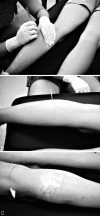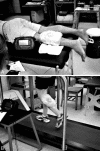Local ice-bag application and triceps surae muscle temperature during treadmill walking
- PMID: 16404447
- PMCID: PMC1323287
Local ice-bag application and triceps surae muscle temperature during treadmill walking
Abstract
Context: Ice bags "to go" are a common practice in athletic training.
Objective: To determine the effect of submaximal exercise on tissue temperatures during a common ice-bag application.
Design: 2 X 5 fully repeated-measures design with treatment (cooling while resting, cooling while walking) and time (pretreatment, immediately after ice application, and at 10, 20, and 30 minutes during treatment) as the independent variables.
Setting: Laboratory setting.
Patients or other participants: Sixteen healthy, physically active volunteers (age = 21.63 +/- 2.63 yrs, height = 68.97 +/- 4.00 cm, mass = 80.97 +/- 18.18 kg, calf skinfold = 21.1 +/- 9.3 mm).
Main outcome measure(s): Left triceps surae intramuscular and skin temperatures, as measured by thermocouples to the nearest 0.1 degrees C, served as dependent measures.
Intervention(s): After collecting baseline temperatures, we secured a 1.0-kg ice bag to the calf using plastic wrap before the subject either rested prone or walked on a treadmill at 4.5 km/h for 30 minutes.
Results: Treatment did not (P < 0.10) affect the approximately 15 degrees C (P < 0.0001) surface temperature decrease, which remained depressed immediately upon ice-bag application (P < 0.05). Conversely, intramuscular temperature continually cooled (34 to 28 degrees C), while subjects rested (P < 0.0001), whereas no change took place during walking (P = 0.49). Moreover, at the 20- and 30-minute treatment intervals, the resting intramuscular temperatures were, respectively, 3.9 degrees C and 5.4 degrees C cooler than the walking intramuscular temperatures (P < 0.01).
Conclusions: The current trend of wrapping "to go" ice bags to the leg is not likely to achieve deep tissue cooling despite surface temperature decreases.
Figures




Comment in
-
Ice bag application, active warm-up, and 3 measures of maximal functional performance.J Athl Train. 2006 Oct-Dec;41(4):364-70. J Athl Train. 2006. PMID: 17273459 Free PMC article.
Similar articles
-
Examination of Intramuscular and Skin Temperature Decreases Produced by the PowerPlay Intermittent Compression Cryotherapy.J Sport Rehabil. 2018 May 1;27(3):244-248. doi: 10.1123/jsr.2016-0244. Epub 2018 May 10. J Sport Rehabil. 2018. PMID: 28422604
-
The magnitude of tissue cooling during cryotherapy with varied types of compression.J Athl Train. 2010 May-Jun;45(3):230-7. doi: 10.4085/1062-6050-45.3.230. J Athl Train. 2010. PMID: 20446835 Free PMC article. Clinical Trial.
-
Effectiveness of Salted Ice Bag Versus Cryocompression on Decreasing Intramuscular and Skin Temperature.J Sport Rehabil. 2019 Feb 1;28(2):120-125. doi: 10.1123/jsr.2017-0173. Epub 2018 Oct 15. J Sport Rehabil. 2019. PMID: 29035620
-
Exercise and quadriceps muscle cooling time.J Athl Train. 2005 Oct-Dec;40(4):260-3. J Athl Train. 2005. PMID: 16404445 Free PMC article.
-
Efficacy of ReBound Diathermy as a Thermal Heating Agent: A Critically Appraised Topic.J Sport Rehabil. 2019 Aug 1;28(6):656-659. doi: 10.1123/jsr.2018-0034. J Sport Rehabil. 2019. PMID: 29952697 Review.
Cited by
-
Assessment of the Dynamics of Temperature Changes in the Knee Joint Area in Response to Selected Cooling Agents in Thermographic Tests.Int J Environ Res Public Health. 2021 May 17;18(10):5326. doi: 10.3390/ijerph18105326. Int J Environ Res Public Health. 2021. PMID: 34067781 Free PMC article.
-
Should athletes return to sport after applying ice? A systematic review of the effect of local cooling on functional performance.Sports Med. 2012 Jan 1;42(1):69-87. doi: 10.2165/11595970-000000000-00000. Sports Med. 2012. PMID: 22121908
-
Ice bag application, active warm-up, and 3 measures of maximal functional performance.J Athl Train. 2006 Oct-Dec;41(4):364-70. J Athl Train. 2006. PMID: 17273459 Free PMC article.
References
-
- Hardy M, Woodall W. Therapeutic effects of heat, cold, and stretch on connective tissue. J Hand Ther. 1998;11:148–156. - PubMed
-
- Knight KL. Cryotherapy in Sport Injury Management. Champaign, IL: Human Kinetics; 1995.
-
- Kellett J. Acute soft tissue injuries: a review of the literature. Med Sci Sports Exerc. 1986;18:489–500. - PubMed
-
- McMaster WC. A literary review on ice therapy in injuries. Am J Sports Med. 1977;5:124–126. - PubMed
LinkOut - more resources
Full Text Sources
